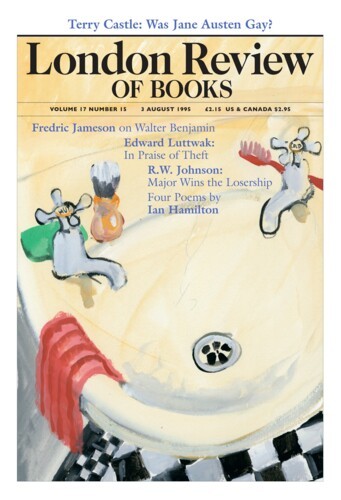A Family Wireless
You switch it on, pour out a cup of tea,
drink it, and finally sounds of outer space
clearing its throat blow from the vizored face;
pause; then the swelling voice of history
refills our kitchen from the B.B.C.
It’s full of static and authority.
I daren’t re-tune it: set before the war
on Home, it doesn’t know it’s Radio Four.
It never knew the Third, or Radio Three.
It was turned off if it tried Comedy.
We stare at the brown gauze: that mouth-like stain
represents years of electronic breath
reading out sentences of war and death,
names we should know, facts that might entertain,
instructive crime and edifying pain.
The angels of the Lord spoke through that gauze
to us. Was it the innocence of youth
to think an angel told the legal truth?
The cat of veracity may have had its claws
retracted, but we knew its powerful paws:
we’d seen the ruins, and the ships on fire;
I met a boy from Belsen, and a man
maltreated by the aesthetes from Japan.
The cat of history, fed but not for hire,
sits on Big Brother at its own desire.
Those messages continue to engage
our trust. Up there above us, on the wall,
the backdrop of our minds, this oracle
still tells the temperature of human rage:
‘Keep calm, the blood is flowing well, off-stage.’
Now it’s our mother’s link to life, her thread
to safety from the labyrinth of the self.
When it stops talking on the mantelshelf,
that silence of significance will spread
even to the newsless circles of our dead.
The Fairy Flag
I
The fairy flag is in a frame
like a picture white on white,
like a fine
tablecloth or shoulder-wrap
too good to stain
on anybody’s theatre-going arm.
If memory serves, there is some
embroidery on it, plain white stitch,
but no sign
of loops for hauling it up –
though it’s twice been flown.
The fairy promised to bring help three times
and they say in 1940 the PM
asked the owner to fly it
to save Britain –
a fairy feathering a Messerschmidt’s prop
for Paul Nash to paint –
but the MacLeod said: No, there’s worse to come.
II
Another label innocently
tells us the flag is silk, and faded
from being red and yellow – someone
has worn it too much in the sun –
and the cross-stitch is Syrian
work of the twelfth or thirteenth century.
This puts a new complexion on the fairy:
not the misty bath-look of a country lady
mysteriously slim, but the pale brown
of a mysteriously plump, veiled woman
of Damascus, in perpetual afternoon
sewing, secluded from the dusty city.
We wonder how her needlework found its way
to this wall. In the coarse hands of some crusader?
Did he come ransoming her Saracen?
Did she give this silk as a safe-passage token
to the horrible Frank? – who’d have a lot to explain
when he got home to his glowing wife in Skye.
Send Letters To:
The Editor
London Review of Books,
28 Little Russell Street
London, WC1A 2HN
letters@lrb.co.uk
Please include name, address, and a telephone number.

